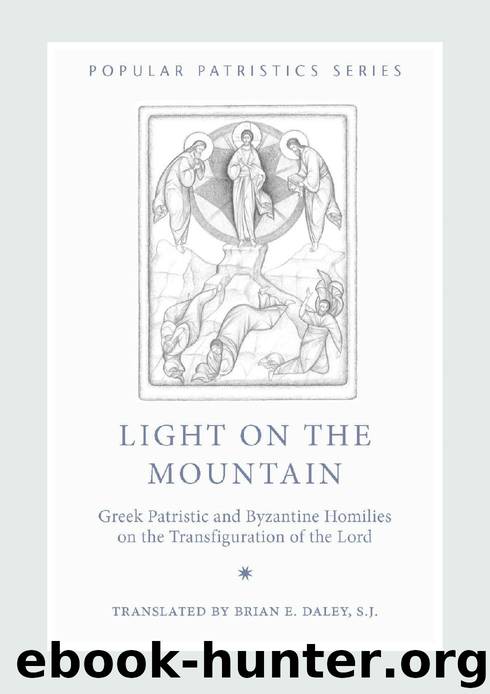Light on the Mountain: Greek Patristic and Byzantine Homilies on the Transfiguration of the Lord (Popular Patristics Series Book 48) by Brian E. Daley

Author:Brian E. Daley [Brian E. Daley]
Language: eng
Format: epub
ISBN: 9780881414653
Publisher: Saint Vladimir's Seminary Press
Published: 2020-04-09T16:00:00+00:00
Notes
1The Greek text for this homily has not been critically edited, and shows some mistakes and omissions, as published. We use, as the only available text, the seventeenth-century edition of François Combéfis, as it appears in PG 97.932–957.
2Andrew begins his homily with a play on words: to recognize the self-emptying of the Logos in the Mystery of the Incarnation is to take off the veil of alogia. Divine reason, in the flesh, makes even fleshly minds reasonable.
3Col 3.2.
4Here, as in his first homily on the feast of the Dormition of Mary (1.7), Andrew depicts himself as host at a banquet, inviting the members of his congregation to join in an intellectual, liturgical, and artistic feast. The resonance of such language with the Eucharistic context is unmistakable.
5See John 19.23.
6Gen 3.19.
7Andrew seems to mean that the one whom Peter has just recognized as “the Christ” (Matt 16.18) is also recognized in the same verse as “Son of the living God,” an identification of Jesus with the Father that is about to be confirmed in the Transfiguration scene by a voice from heaven. It is in his humanity that Jesus is “anointed” with the Spirit who makes God’s presence real; but this scene shows that the person who receives this anointing in his humanity is actually himself God the Son.
8In speaking of the “unconfused union,” in which the divine person of the Word makes the fullness of human nature his own, without annihilating it, Andrew echoes the understanding of the Christology of Chalcedon that came to dominate sixth-century Orthodoxy.
9In this dense passage, Andrew presents the Christological significance of the Transfiguration: it is a revelation, in the person of the Word made flesh, of the divinization offered through him to all who share his human nature. It is a glimpse of the destiny of redeemed humanity.
10Lam 3.34 (LXX).
11In this sentence and the next, as he tries to define more clearly the aim of his sermon (logos), Andrew deftly plays with terms having to do with logos: “word,” “speech,” or even “reason.” His intention is to speak about the limits of speech itself, and about this miraculous revelation which enabled the disciples to gaze on what speech can never describe.
12Reading enikēthē for the Patrologia’s enikēsen, which seems to make little sense here.
13Combéfis, who first published the text of this oration, prefers to read hyperartheisi tō logō, rather than epartheisi tō logō, as his manuscript indicates (and as appears in the Patrologia): “raised up beyond themselves,” rather than simply “raised up.” This seems to be what Andrew means here, but it is not clear that he expressed his idea with this word.
14Matt 16.28–17.2.
15Like most ancient authors, Andrew assumes that the evident similarities in text between Matthew’s and Mark’s Gospels are due to Mark’s imitating Matthew, and not (as most modern critics assume) the other way around.
16John 21.25.
17Luke 9.28–29.
18Echoing the language and style of the Pseudo-Dionysius, as well as of the earlier Greek tradition of mystery religions, Andrew speaks here in the language of initiation into solemn rites that reveal religious truth inexpressible by ordinary language.
Download
This site does not store any files on its server. We only index and link to content provided by other sites. Please contact the content providers to delete copyright contents if any and email us, we'll remove relevant links or contents immediately.
Signature in the Cell: DNA and the Evidence for Intelligent Design by Stephen C. Meyer(2879)
Real Sex by Lauren F. Winner(2870)
The Holy Spirit by Billy Graham(2779)
The Secret Power of Speaking God's Word by Joyce Meyer(2756)
The Gnostic Gospels by Pagels Elaine(2400)
Jesus by Paul Johnson(2230)
Devil, The by Almond Philip C(2207)
23:27 by H. L. Roberts(2144)
The Nativity by Geza Vermes(2117)
Chosen by God by R. C. Sproul(2057)
All Things New by John Eldredge(2052)
Angels of God: The Bible, the Church and the Heavenly Hosts by Mike Aquilina(1870)
Angels by Billy Graham(1845)
The Return of the Gods by Erich von Daniken(1843)
Knowing God by J.I. Packer(1726)
Jesus of Nazareth by Joseph Ratzinger(1710)
Evidence of the Afterlife by Jeffrey Long(1705)
The Gnostic Gospel of St. Thomas by Tau Malachi(1682)
How To Be Born Again by Billy Graham(1671)
